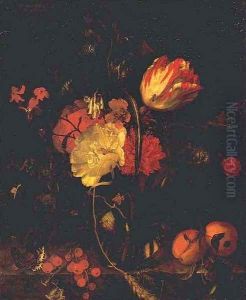Maria van Oosterwijk Paintings
Maria van Oosterwijk was a Dutch artist celebrated for her mastery in still-life painting, particularly known for her detailed and vibrant floral arrangements. She was born in 1630 in Nootdorp, near Delft in the Netherlands. Van Oosterwijk's talent in painting was evident from a young age, though the specifics of her early training are not well-documented. It is believed that she was a pupil of Jan Davidsz. de Heem, a prominent still-life painter of the time, who had a significant influence on her style.
Van Oosterwijck's career flourished in a period when it was challenging for women to gain recognition in the arts. Despite these obstacles, she became one of the few female artists of her time to achieve fame and financial independence through her work. Her paintings often depicted bouquets of flowers in ornate vases, and her skill lay in her ability to render textures and surfaces with great precision and to create a sense of depth and realism.
She attracted a European clientele, and her works were sought after by patrons including Louis XIV of France and William III of England. Her success is evidenced by the high prices her paintings fetched and by the fact that she remained unmarried, which was unusual for women of her era, suggesting that she was able to support herself through her art.
Maria van Oosterwijck remained active as an artist until her later years, and she continued to enjoy the patronage of influential and wealthy art collectors. Her legacy includes not only her stunning still-life compositions but also her role in paving the way for future generations of female artists. She died in 1693 in Uitdam, where she had moved later in life. Her works can be found in various museums and art collections around the world, serving as enduring examples of her skill and artistry.
